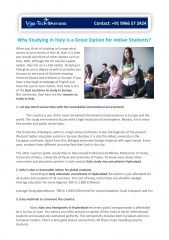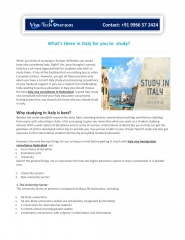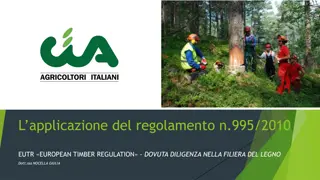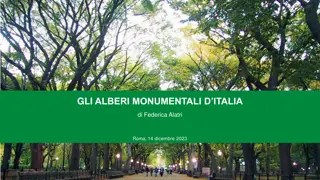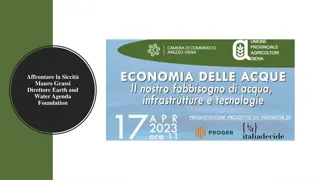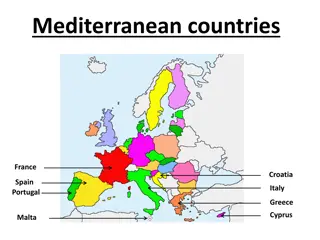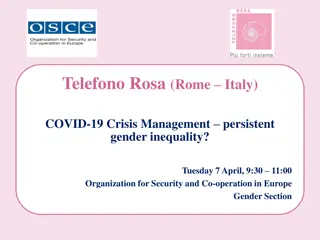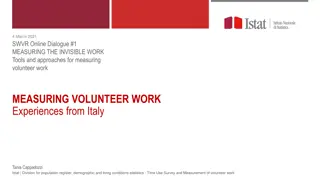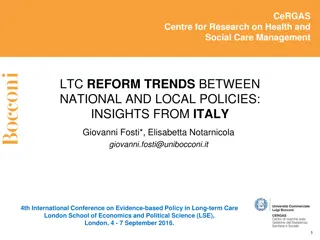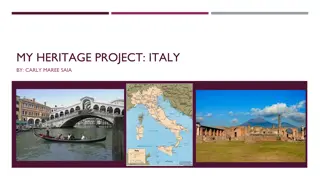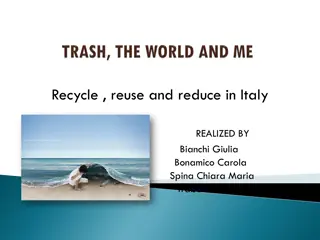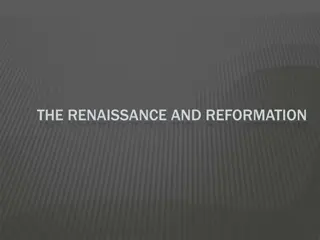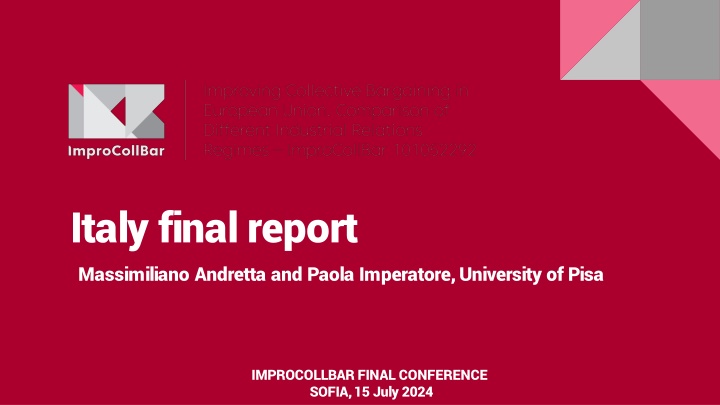
Collective Bargaining Trends in Italy: Recent Developments and Challenges
Explore the state of collective bargaining in Italy with insights on recent trends, challenges, trade union membership, the impact of COVID-19, and various stakeholder perspectives. Discover how decentralization, social partner opinions, and the question of representativeness shape the landscape of collective bargaining in Italy.
Download Presentation

Please find below an Image/Link to download the presentation.
The content on the website is provided AS IS for your information and personal use only. It may not be sold, licensed, or shared on other websites without obtaining consent from the author. If you encounter any issues during the download, it is possible that the publisher has removed the file from their server.
You are allowed to download the files provided on this website for personal or commercial use, subject to the condition that they are used lawfully. All files are the property of their respective owners.
The content on the website is provided AS IS for your information and personal use only. It may not be sold, licensed, or shared on other websites without obtaining consent from the author.
E N D
Presentation Transcript
Italy finalreport Massimiliano Andretta and Paola Imperatore, University of Pisa IMPROCOLLBAR FINAL CONFERENCE SOFIA, 15 July 2024
The state of collective bargaining in Italy
Collective barganing in Italy: recent trends Long tradition of CB, but also challenges linked to: Transformations in political and economic context multiplication of autonomous unions at both the industrial and company level
Trade unions membership and other characteristics Table 1. Trends of the principal characteristics of the Italian main trade union landscape Total trade Union Membership (retired excluded) Share of Women Density Number of confederations Number of federations Number of independent confederations Collective bargaining coverage (Industry level) 1980 7.189. 000 35.0% 35.6% 2000 5.194. 500 38.3% 34.8% 2010 5.920. 900 n.a. 35.1% 2019 6.488. 400 45.0% 32.5% 5 7 ? ? ? 8 82 2 52 4 47 5 80% 80% 30% 80% 30% 80% 30% CBP (decentralized agreements) Days not worked for strikes per 1,000 workers Source: Leonardi and Pedersini (forthcoming), integrated by Pedersini (2019) and ICTWSS 1.135 58 68 n.s. Database ?
The Impact of COVID-19 on Collective Bargaining in Italy During pandemic collective bargaining reinforced and trade union power increased in the management of the crisis Decentralized negotiation became more relevant Despite these developments, trade unions' involvement in the definition of the National Recovery Plan was disappointing.
Qualitative analysis problems and challenges related to CB in social partners opinions
The representativeness Who has the right to represent the workers or the employers and to sign the collective agreements? Grassroots unions They want the right to negotiate in all the workplaces/sectors Confederal TU Main EO They agree on the request for a law of representativeness to ensure that negotiation occured just between most representative organizations *(several agreement already define the actors in negotiation)
Main TU & EO opinion that fragmentation on both the union and employer sides has led the number of national contracts from a total of about 300 to about 1,000 in just 10 years, of which only 280 bear the initials of the three sectoral confederations. This is the main problem today [...] in the absence of laws regulating representation and representativeness, the question arises of downward competition from contracts signed by associations of little or no representativeness (CGIL). pirate trade unions that profit from the possibility of signing agreements where there is no difference between employer and union organisations and that are bordering on fraud (UIL).
Grassroots TU opinions The problem with bargaining in Italy is who does it, and therefore how the choice of bargaining actors is articulated. For us it is the biggest problem, in the sense that in the absolute absence of effective and functioning legislation to identify union representation, and therefore who has the right to sit at the negotiating tables, we are absolutely at the mercy of the counterparts, who choose the actors to sit at the table [...] today the situation is that the confederal organisations make an effort to exclude an organisation like ours even from the various tables (USB) Although in practice we represent the largest presence in the various logistics warehouses, we are outside the national contract while the confederal unions, which no longer count for anything within these sectors, can bargain (SI.Cobas).
The minimum wage In Italy no minimun wage In 2023 the topic become pivotal in public debate but at the end it has been reject by public institution Trade unions support minimun wage, with different level of engagement Confederal TU and the main EO support that the extension of collective bargaining is the main tool to fight poor work
Other topics: wage dumping, renewal times, new forms of labour, innovation wage dumping, that is reconducted to the issue of representation: non-relevant trade unions sign agreement that are pejorative in terms of wage, rights and integrative treatments long renewal times (until 36 months) and the delay in collective agreements renewal: this impact on the wage adjustment in line with inflation, by eroding the purchasing power of workers extension of collective bargaining to old and new sectors taking into account different context in the country scarce level of innovation and backwardness of human resources in the Italian labour market
Some general remark about collective agreement in Italy Consolidation of a bilateral pattern of bargaining Marginal role of State (with some exceptions such as during the Conte bis government or for what concerns law on representation) Potential risks: the bargaining is the product of a confrontation between two private parties. Each with its own powers of persuasion. But since there is no public regulator in this area to guarantee certain aspects of bargaining, it remains an instrument entirely in the hands of private organisations.
Quantitative report: the Protest Events Analysis
445 Protest Events Two peaks: The end of the employment termination freeze (July-21) The discussion of the Draghi s budget law (October-December 2021)
Level Sector LEVEVEN Frequency Percentage Validi Neighbourhood City Province Region Country EU? Level 12 200 32 76 124 2,7 44,9 7,2 17,1 27,9 0,2 1 Target
Role Trade unions frequence in PEs INTRUN Frequency Percentage Validi Participants Co-Initators Initiators No? Involvemen Totale 19 33 271 122 445 4,3 7,4 60,9 27,4 100 Repertoire Claims 15,7 Strike 1,2 March/Rally 7,9 Other? Demonstrative Perturbative Violent Police 152 203 267 40 34,2 45,6 60 Economic? Claims Democracy? Claims Cultural? claims 404 21 60 90,8 4,7 13,5 9 5 0,1 3,6 16
The protest as a resource in collective bargaining The field of protest is also important for building alliances capable of providing trade unions with societal power and resources aimed at improving collective bargaining, as our map of good practices in collective bargaining revealed
Case title Mondo Convenienza CCNL for riders Smartworking Workers safety protection GKN closure May 2023 January 2024 2018 ongoing 2021 2021 2021 - ongoing Time frame Si.Cobas Prato e Firenze + other SMOs, ANPI, local institutions Riders Union Bologna; other riders organizations; NIdiL CGIL, CISL and UIL CGIL, UIL, USB, CISL, UGL; Confindustria, Confartigianato, etc. Minister of Labour USB Education sector GKN Factory Collective + Si.Cobas Prato e Firenze, associations (Arci, Anpi, etc.), local institutions and SMOs Actors Company level Sector level Delivery services National level Sector level (nursery and elementary school) First factory level, then sector level Scope Strike, mobilization, permanent presidium, legal action CCNL signed by confederal Strike, legal action, legislative purpose Digital Workers' Bill of Rights Social dialogue Informative action; pressure on institution Demonstrations, symbolic actions, appeals, festivals, cultural productions, crowdfunding, mutualism practices.. Repertoire Application Logistics and Transport CCNL to workers in furniture chain Mondo Convenienza (6.000 workers) CCNL UGL Assoldelivery (2021) contested by riders New CCNL Just Eat - NIdiL CGIL, UIL and CISL (goal is the extension to all the Signature of the National Protocol containing the guidelines for collective bargaining on agile work in the private sector Introduction of FFP2 masks for personnel working with children between 0 and 6 years. Not yet definitive . 3-year redundancy freeze Results Probable creation of a regional consortium

